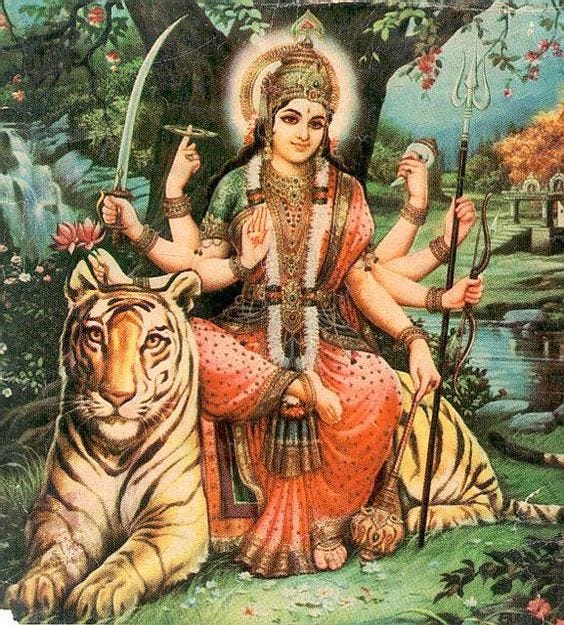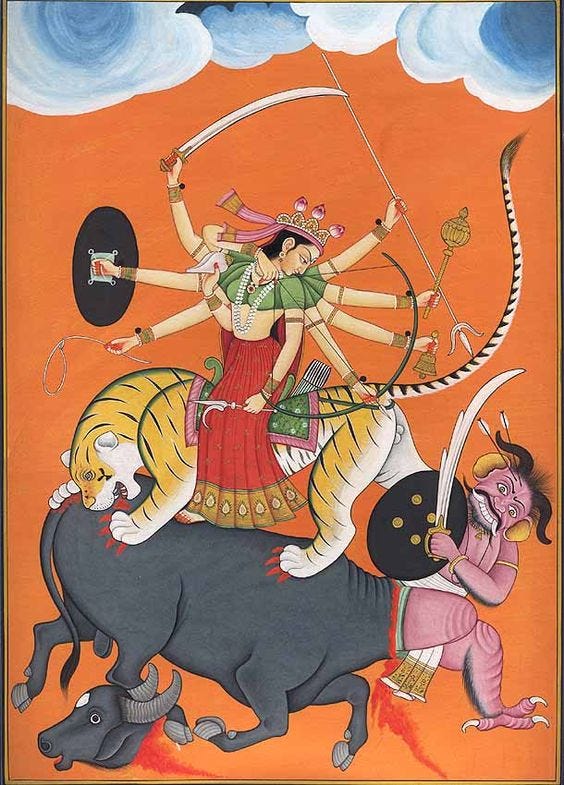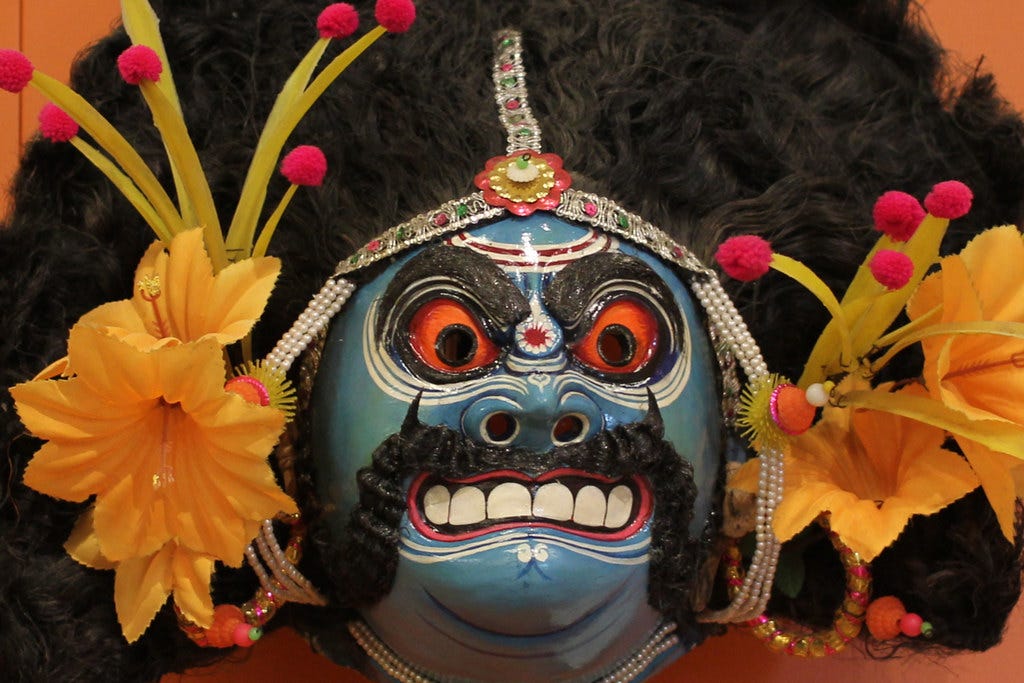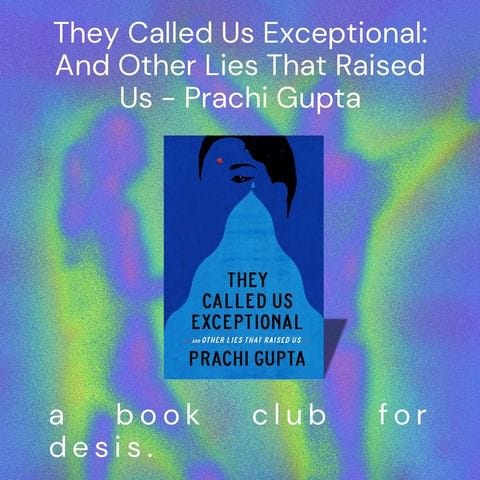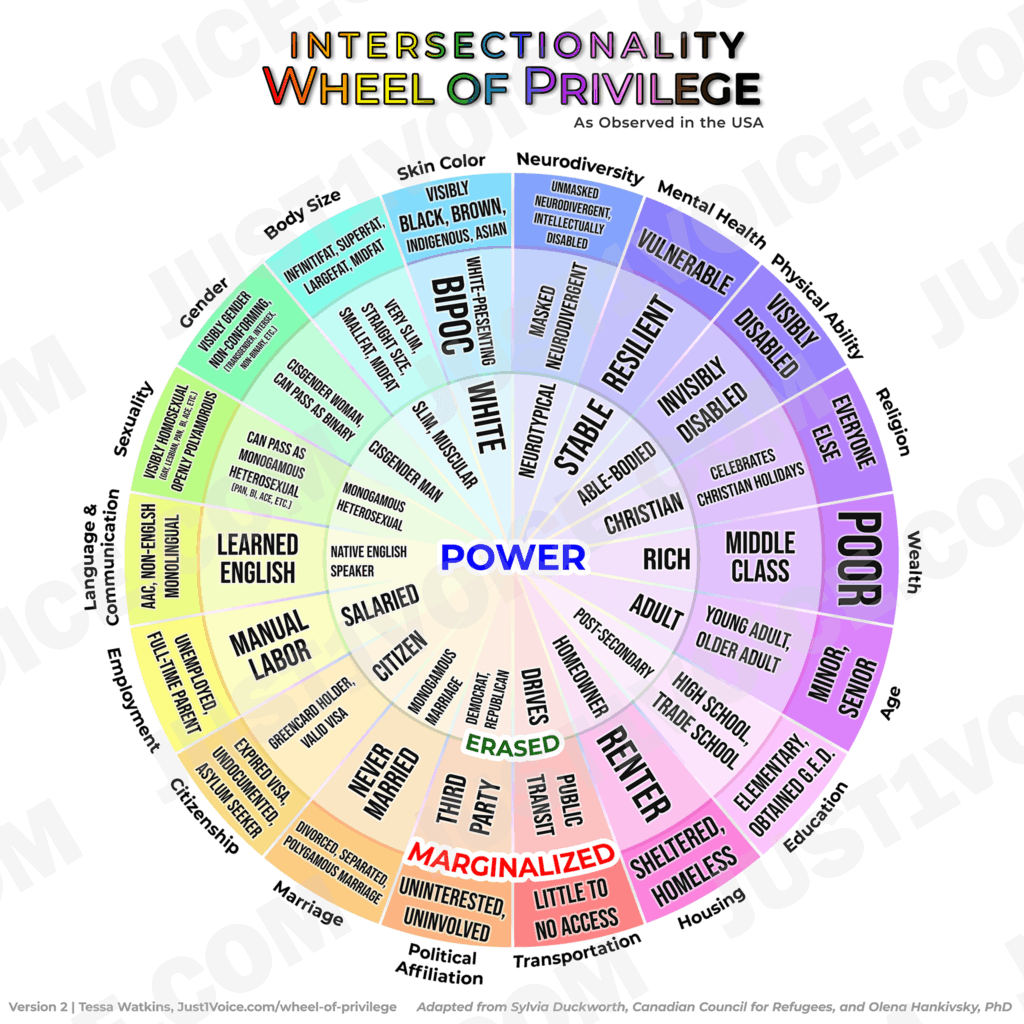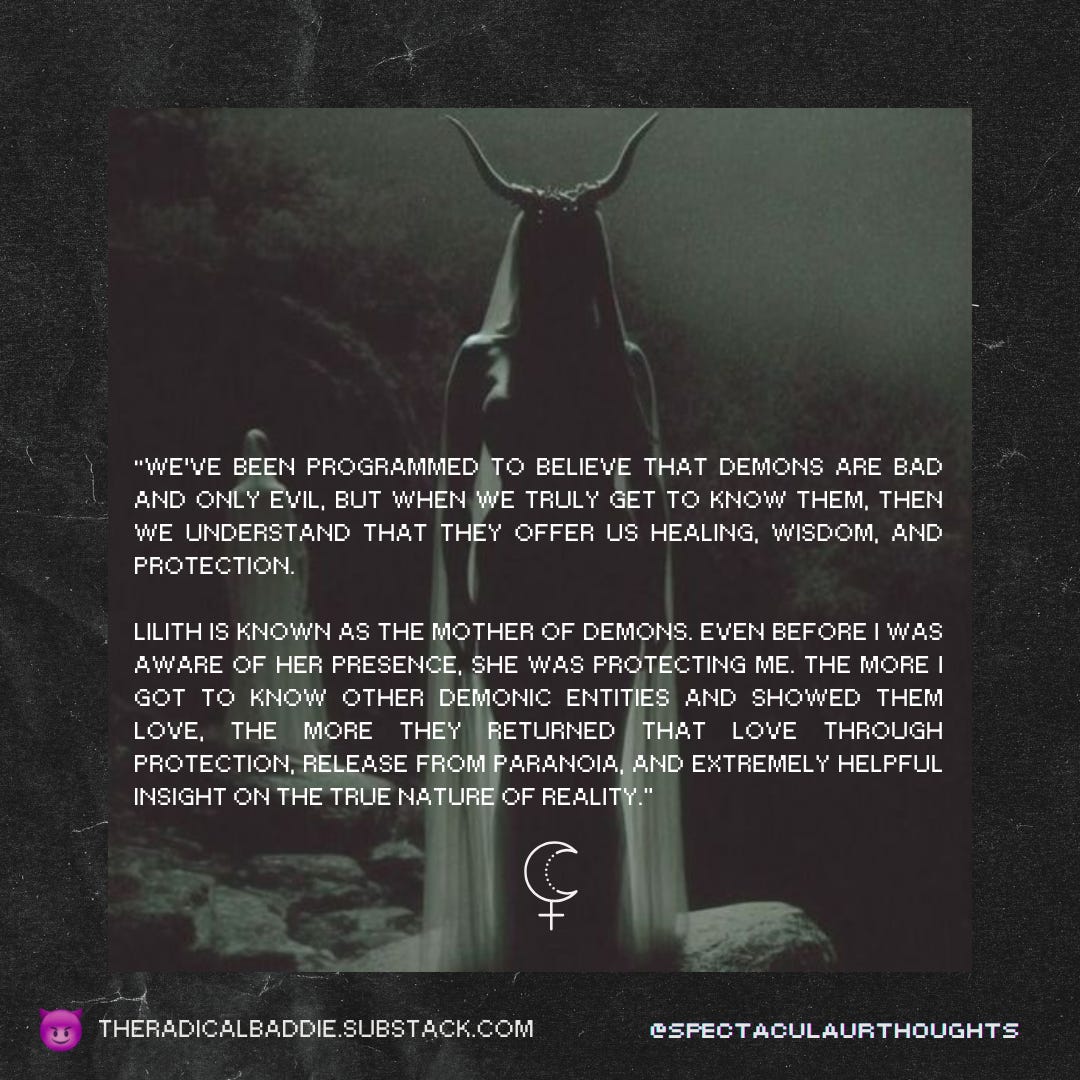Examining the Light & Shadow of the Goddess/Self
Ancestral healing through re-examining mythology and encountering the shadow on the spiritual path
This essay is a reflection on the epic power of stories to create and destroy. Even if you’re not familiar with Durga from the Hindu tradition, you likely do relate to a complex Durga-like mythical figure in your life. There is universal ancestral healing work through examining and rewiring narratives towards liberation - it’s something we all can participate in.
🦁 Durga the Warrior Goddess
I love Durga. I grew up with her stories and she was a symbol of empowerment, reminding me I cold do anything I put my mind to. She fought for justice and destroyed evil! She has cool weapons and tools! She’s firy and rides a tiger! She is the OG social justice warrior!
I’ve written about Durga here before. I attended Durga’s Tiger Tantra School. I just can’t emphasize enough how much I love Durga, how her stories and image were a formative symbol in my childhood. Durga was the font of feminist mythology in my family. She is widely beloved and worshipped across India in one of our most famous religious traditions, Navratri, which is 9 nights of worshipping Maa Durga in her many forms. She might be the most famous, iconic, globally known of all the Hindu goddesses.
Durga is a warrior who is often depicted as a beautiful woman with many arms, riding a lion or tiger, and wielding weapons. She is associated with protection, motherhood, and strength, but can also represent destruction and war. Durga's legend is about fighting evil and demonic forces that threaten peace and prosperity, and she is believed to use her divine feminine energy, known as shakti, to defeat these forces.
Durga’s story in this classical form is quite like the hero’s journey.
And, like all of the gods, goddesses, and gurus in every spiritual tradition1, Durga has a shadow side as well. We know from Jungian psychology that there’s wisdom in examining the shadow. Today we’re exploring the more complicated and even oppressive side of Durga.
🌑 The Shadow Side of Durga
“Durga’s shadow is harshness and the need for control. Her shadow manifests when she is invoked in the service of egoic aims. Negative Durga can be self-righteous and critical. In your inner world, she can show up as a relentless inner critic… Ripping through obstacles, she can also rip apart the fabric of things. Fighting injustice, she visits her sword on anyone or anything that stands in her way. If you earn Durga’s dissaproval, she is likely to stick you in her box marked ‘demon’ and keep you there for a long time."
Sally Kempton, Awakening Shakti
In Awakening Shakti, Kempton profiles a variety of Vedic and Tantric goddesses stemming from the Hindu tradition. For each, she examines their shadow side in depth.
Kempton describes Hillary Clinton as the quintessential Durga woman. She says Meryl Streep’s character in the Devil Wears Prada embodies the essence of Durga’s shadow. Second Wave (White) feminism is Durga energy. The Model Minority myth is one that parallel’s Durga’s story. America as a concept is quite like Durga in its complex dominant and counternarratives.
You can begin to see how Durga, in all her righteous quest for justice, can also be a storm of harm.
👹 The People’s Hero
Until lions have their own historians, tales of the hunting shall go on glorifying the hunter.
African Proverb
Beyond the shadow, our beloved figures of myth can in truth be the villain.
Durga’s key story2 is the battle against the buffalo demon Mahishasura.
The story goes that buffalo demon Mahishasura, after receiving a boon that made him invincible against any man or god, wreaked havoc on the heavens and earth. Unable to defeat him, the gods combined their energies to create a powerful goddess, Durga, who would vanquish the demon.
On the surface, it seems like this story is an ahead of its time empowering feminist tale.
But it conceals a powerful counternarrative:
Many Dalits and Adivasis consider Mahishasur to have been an indigenous king who was killed during the [Aryan] invasion, and accuse upper-caste Hindus of demonising him as part of an effort to suppress narratives of resistance against Brahminism. By way of example, Anil Asur, a social activist from Jharkhand, told me that schoolbooks often glorify myths of Hindu gods killing people from his Adivasi community, the Asurs, who are portrayed as demons. In fact, he said, these “were mass murders of our valiant ancestors.”
The Asurs often claim Mahishasur as an ancestor, as do Adivasi groups such as the Santhal and Bhil, and the Yadav, Kushwaha and Kumhar castes, among countless others. Naresh Kumar Sehni, a social activist from Bihar, put forward one possible explanation for Mahishasur’s broad appeal. “I don’t think the caste system existed in Mahishasur’s time in the present form,” he told me. And because “his caste cannot be determined,” he said, Mahishasur “is the hero of all indigenous inhabitants of India.”
Read More: Mahishasur: The Forgotten Hero of Bengal’s Indigenous People, Facing Demons the Reclamation of Mahishasur as a heroic figure, The Tale of Mahishasur and Durga: the Missing Story of the Tribal Hero
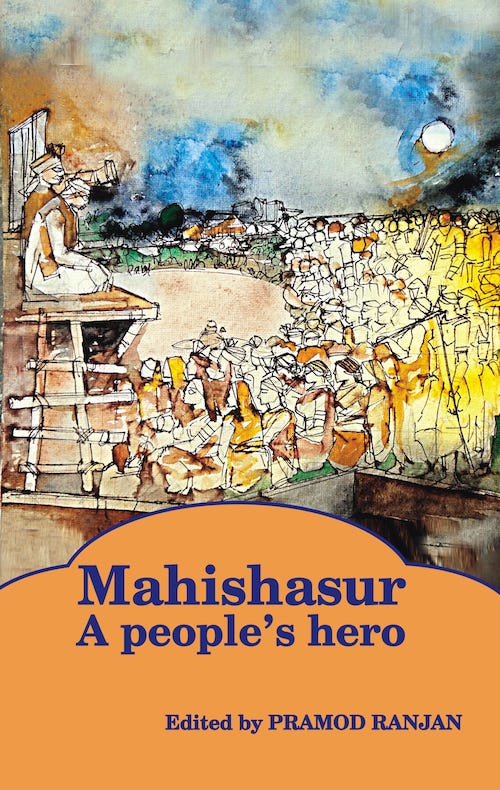
In ‘A People’s Hero,’ the counternarrative is unfurled. Mahishasur was a mighty, just and popular Asur (non-Aryan, Indigenous) ruler. When the Aryans found it impossible to defeat him in battle, they killed him by deceit using the charms of a woman, whom they subsequently called Durga. They mythologized the incident and began to worship her as Goddess.3
Truth has many faces, and often the most popular stories are the most distorted versions of truth. They are the stories of the hunters, not the hunted.
As an upper-caste light-skinned class privileged Brahmin woman, it’s especially important for me to dissect Durga’s mythology I inherited.
Dominant narratives like Durga’s reinforce systems of supremacy.
Consciousness, enlightenment, caste abolition, liberation - they require us to examine and deconstruct mythology because ALL Economic and Political systems of supremacy are enforced through Culture (ideas, stories, symbols).
The most powerful place for us to be doing organizing, movement, liberation work is in deconstructing our inherited mythology and re-constructing them towards a future we want.
Story analysis and story crafting give us agency in the stories we want to uplift instead to elevate collective consciousness. It’s why this whole publication is about loving the mad, bad, and wild - the archetypes that have been discarded, demonized, villainized in our collective. This weekly devotional is learning to love our shadow so instead of ruling us, we’re able to resolve patterns of trauma and reclaim ancestral gifts and resources, wielding them in the direction of healing and liberation.4
💡 There are some really incredible Dalit creatives, storytellers, futurists who lead the way. Manu curated Dalit Dreamlands on exhibit currently at the Oakland Asian Cultural Center. Nrithya Pillai is a Bharatnatyam dancer “de-problematizing”, deconstructing, de-Brahmanizing the ancient dance form. Prachi Patankar is an analyst, scholar, and writer.
📑 Learn more about Storytelling for Social Justice, Narrative Initiative
📚 For Desis who are looking for more deconstruction of our inherited familial mythologies, check out Prachi Gupta’s new book They Called Us Exceptional and Other Lies that Raised Us, which is a memoir on the toll the model minority myth has taken on her Indian American family. I’m looking forward to reading and participating in Alchemystic Studio’s book club this fall:
🕸️ Spiritual Integrity
Confronting the shadow of dearly beloved divine ideas is inevitable on a path of pursuing spiritual integrity.
“What is spiritual integrity? The Latin root of integrity means soundness, wholeness, completeness. The French root means innocence, blamelessness, purity.
How can we learn to detect a violation of spiritual integrity before we are blinded by devotion or belief? That is, how can we cultivate shadow awareness, maintain our internal warning systems, and be guided by those higher voices, rather than by past wounds that keep us in traumatic patterns?
In professional religious or spiritual domains, this means the creation of institutions that honor both the autonomy of individual life and the interdependence of all life… This antidote would also include cultivating shadow awareness in ourselves and towards others so we are attuned to our own susceptibilities and to those of our teachers or clergy. If there’s a whiff of violation of spiritual integrity, we can turn within to trust our own intuition.
I am calling for a reimagination of religious and spiritual life… that expands to include the human shadow. It is not absent in anyone. It is not going anywhere. It is an inevitable part of the human search for identity and journey toward union with the divine.”
Meeting the Shadow on the Spiritual Path, Connie Zweig
My spiritual awakening at its core was a realization of the connectedness of everything 🦠 I began to feel in my life the tensions between my work, my politics, my spirituality (or lack thereof). Awakening and enlightenment move us towards seeking alignment in our selves, in our lives. We all ultimately want INTEGRATION. We long to feel connected in our Mind-Body, to the collective, to the planet.
In Dr. Zweig’s book, she argues that no matter the spiritual path we choose, we inevitably encounter our own shadow, the unconscious aspects of ourselves that we suppress or deny. We also encounter the shadows of our teachers and their secret desires about money, sex, and power. These are microchosmic representations of the collective shadow and even the shadows of divine figures themselves.
Meeting the shadow or dark is inevitable when walking the spiritual path, undergoing a healing journey, or simply consciously living. If you’re encountering the shadow in your self, your teacher, your relationship to the divine, I’d say you’re doing it right. Stay metal, friends.
✍🏽 Reflection/Journal Prompts
Consider your own shadow mythologies and consider what spiritual integrity means to you:
How am I like Durga? How am I like Mahishasura?
What role do privileged and powerful women play in maintaining systems of supremacy?
What are the narratives that shape my values and belief systems? Are they dominant narratives or counternarratives?
How is Durga’s mythology similar to my family’s core mythology?
Is my vision for justice individual or is it collective?
In my quest for justice, how do I cause harm?
When does my rage or my temper no longer serve a higher, divine agenda?
How can I come to know and love my own Mahishasur, who archetypally represents my shadow?
How do I learn to relate to, have compassion for my demons?
This is just the tip of the iceberg. Welcome to a lifetime of becoming aware of your unique positionality, unlearning and relearning towards liberation.
I think systems of supremacy are less rigid hierarchical structures, and more like dynamic webs. Our position in the web shifts depending on the context that we’re in. We are all oppressor-oppressed, hero-villain, light-dark. There is no rigid binary!!
The hero’s myth, good girl programming, the cultural myth of white supremacy or Brahmanical supremacy - these are all examples of dominant narratives that ultimately suffocate us. We think by being perfect, hustling, achieving financial stability or security, breaking glass cielings, being “the first” or “the only” will help us achieve safety and security.
What would it mean if we instead believed in the inherent dignity of our selves and all other people on this planet? What if we started re-orienting our lives and actions towards this vision of wholeness and connectedness?
Cycle breakers are the ones taking on the painstaking work of unraveling patterns of trauma in their family lineage, decoding the fear and shame, and doing the work of healing in order to integrate and begin new patterns of reconciliation, restoration, and liberation. Doing the work of examining our ancestral narratives and reclaiming spiritual traditions for the modern moment in time we’re in is ancestral healing in action.
🌎 Nourishing Spiritual Integrity: Meeting Durga’s Sisters
One way I nourish my spiritual integrity is by widening the aperture of the stories of goddesses I relate to. These images return me back to an idea of wholeness, universal connectedness. the divinity in my self and body.
The Brahmanical Patriarchal portrait of Durga as Supreme Goddess is incomplete. Durga is just one face of a brilliant kaleidoscopic portrait of older, more diverse goddesses. They are complicated, chaotic, disorderly, sensuous, earthly.
Stay tuned for a bonus Part Two later this week where I’ll be sharing the profiles of the 10 Mahavidyas, the 10 Tantric Goddesses.
It is written in the Devi Mahatmya (part of the Markandeya Purana, dating from the 5th to 6th centuries CE). This is one of the primary or original myths cited for Durga, but the Goddess existed long before in other forms before being written and captured in this way for the Aryan sociopolitical agenda.
Mahishasur: The People’s Hero a solid review of the text that walks through how the creation of the Durga/Mahishasur myth reflects the true sociopolitical events of war between the nomadic, light-skinned, warrior class Aryans against the Indigenous people of India
A few weeks ago I profiled Laurel who discussed learning to love our demons and unpacked a myth of marginalized Dark goddess - Lilith



